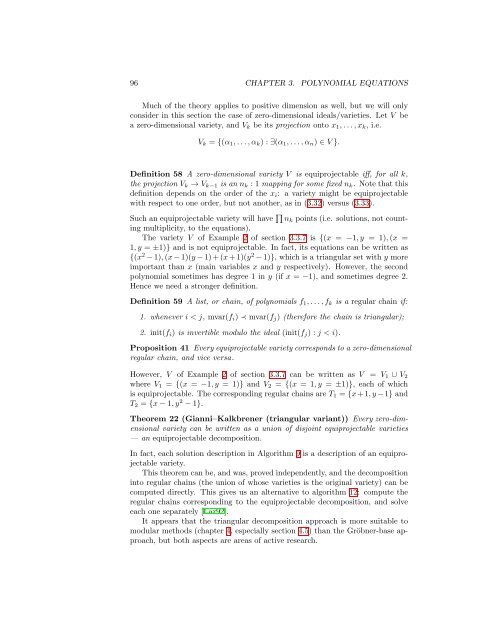Contents - Student subdomain for University of Bath
Contents - Student subdomain for University of Bath
Contents - Student subdomain for University of Bath
You also want an ePaper? Increase the reach of your titles
YUMPU automatically turns print PDFs into web optimized ePapers that Google loves.
96 CHAPTER 3. POLYNOMIAL EQUATIONS<br />
Much <strong>of</strong> the theory applies to positive dimension as well, but we will only<br />
consider in this section the case <strong>of</strong> zero-dimensional ideals/varieties. Let V be<br />
a zero-dimensional variety, and V k be its projection onto x 1 , . . . , x k , i.e.<br />
V k = {(α 1 , . . . , α k ) : ∃(α 1 , . . . , α n ) ∈ V }.<br />
Definition 58 A zero-dimensional variety V is equiprojectable iff, <strong>for</strong> all k,<br />
the projection V k → V k−1 is an n k : 1 mapping <strong>for</strong> some fixed n k . Note that this<br />
definition depends on the order <strong>of</strong> the x i : a variety might be equiprojectable<br />
with respect to one order, but not another, as in (3.32) versus (3.33).<br />
Such an equiprojectable variety will have ∏ n k points (i.e. solutions, not counting<br />
multiplicity, to the equations).<br />
The variety V <strong>of</strong> Example 2 <strong>of</strong> section 3.3.7 is {(x = −1, y = 1), (x =<br />
1, y = ±1)} and is not equiprojectable. In fact, its equations can be written as<br />
{(x 2 − 1), (x − 1)(y − 1) + (x + 1)(y 2 − 1)}, which is a triangular set with y more<br />
important than x (main variables x and y respectively). However, the second<br />
polynomial sometimes has degree 1 in y (if x = −1), and sometimes degree 2.<br />
Hence we need a stronger definition.<br />
Definition 59 A list, or chain, <strong>of</strong> polynomials f 1 , . . . , f k is a regular chain if:<br />
1. whenever i < j, mvar(f i ) ≺ mvar(f j ) (there<strong>for</strong>e the chain is triangular);<br />
2. init(f i ) is invertible modulo the ideal (init(f j ) : j < i).<br />
Proposition 41 Every equiprojectable variety corresponds to a zero-dimensional<br />
regular chain, and vice versa.<br />
However, V <strong>of</strong> Example 2 <strong>of</strong> section 3.3.7 can be written as V = V 1 ∪ V 2<br />
where V 1 = {(x = −1, y = 1)} and V 2 = {(x = 1, y = ±1)}, each <strong>of</strong> which<br />
is equiprojectable. The corresponding regular chains are T 1 = {x+1, y −1} and<br />
T 2 = {x − 1, y 2 − 1}.<br />
Theorem 22 (Gianni–Kalkbrener (triangular variant)) Every zero-dimensional<br />
variety can be written as a union <strong>of</strong> disjoint equiprojectable varieties<br />
— an equiprojectable decomposition.<br />
In fact, each solution description in Algorithm 9 is a description <strong>of</strong> an equiprojectable<br />
variety.<br />
This theorem can be, and was, proved independently, and the decomposition<br />
into regular chains (the union <strong>of</strong> whose varieties is the original variety) can be<br />
computed directly. This gives us an alternative to algorithm 12: compute the<br />
regular chains corresponding to the equiprojectable decomposition, and solve<br />
each one separately [Laz92].<br />
It appears that the triangular decomposition approach is more suitable to<br />
modular methods (chapter 4, especially section 4.5) than the Gröbner-base approach,<br />
but both aspects are areas <strong>of</strong> active research.












![[Luyben] Process Mod.. - Student subdomain for University of Bath](https://img.yumpu.com/26471077/1/171x260/luyben-process-mod-student-subdomain-for-university-of-bath.jpg?quality=85)



